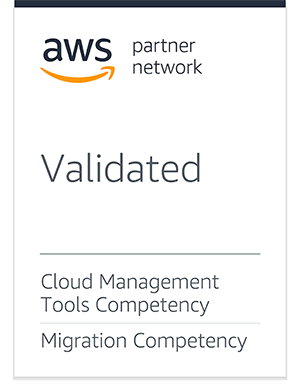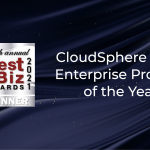CloudSphere Continues to Add Value for Clients by Achieving AWS Migration and Modernization Competency
CloudSphere is honored to achieve AWS Migration and Modernization Competency for discovery and planning – a designation that demonstrates superior technical capabilities and expertise required for successful enterprise migrations to AWS. CloudSphere is  unique in that we also hold an AWS Management Tools Competency in the Cloud Governance category to simplify the ongoing management of cyber assets once in the cloud.
unique in that we also hold an AWS Management Tools Competency in the Cloud Governance category to simplify the ongoing management of cyber assets once in the cloud.
Taken together, these competencies reflect CloudSphere’s deep expertise and proven customer success in helping global organizations move business services into AWS and also optimize cyber asset management on an ongoing basis. Let’s take a deeper dive into the CloudSphere approach, and how our expertise is helping ensure clients have unique and comprehensive capabilities at their disposal to accelerate transformation and business value in the cloud.
The 6Rs of Migration are a Starting Point, not a Destination
The best way to summarize how we view migration, and what helped us earn this Migration and Modernization Competency from AWS, is that we view the famous “6Rs of migration” as more of a starting point than a destination. The reality is each of the 6Rs of migration – Retiring, Retaining, Rehosting, Replatforming, Refactoring and Re-architecting – has its own drill down levels of complexity that must be explored and managed.
To CloudSphere, the 6Rs are the framework for a deeper and granular analysis into your architecture and assets – a level of analysis for discovery and planning necessary for organizations to fully navigate and optimize their multi-cloud environments. Unfortunately, not every company takes such a rigorous approach. It’s easy to define discovery as the process in which tooling is used to scan and identify current environments, but how you go about it can be the difference between solving or adding to your modernization challenges.
For instance, lots of solutions are currently agent-based – very intrusive, involving software that runs on the endpoints. This creates two major problems. The first is the Catch 22 derived from the fact that, to install this software, you need to know where all the endpoints reside; yet discovery is the process of trying to find these endpoints to begin with. So, in effect, an agent-based approach is primarily helping you discover only what is already known. The second problem with agent-based discovery is that the agent software can strain capacity and processing load. This adds extra latency and compute costs, thereby altering the performance of the assets an organization is trying to measure, especially when discovery may be happening during periods of peak performance.
Unfortunately, with traditional discovery approaches, even when you find the right servers and provision the capacity and compute to run software agents, you may not have continuous visibility and control over asset behaviors. For instance, you may be missing programs that only run intermittently, perform batch processes or have components that are triggered at certain times. And many modern technologies are increasingly ephemeral and dynamic around when they are running or terminated.
Other challenges involve installing discovery software on production systems, which may require more security sign-offs and evaluations for potential SLA impacts. This is compounded by the fact that multiple third parties may be involved in this discovery process, raising potential risks to an enterprise’s most sensitive systems in a production environment.
Advanced Discovery and Planning for Migration Excellence
Turning optimal discovery and planning designs into reality requires a different approach. To begin with, an agentless solution is necessary to avoid the pitfalls mentioned above in favor of more scalable and dynamic methods for discovery that create a continuous improvement cycle of discovery, validation and re-discovery.
CloudSphere embraces the agentless model and delivers a secure, ongoing discovery and planning process via an appliance that’s installed in the environment. This minimizes disruption to production while unlocking automation to dynamically scan for assets and their interrelationships on an ongoing basis. The agentless approach also adds scale to what and how much of the cloud environment can be scanned within a given discovery scope.
The difference is like going from periodic, grainy snapshots of your architecture in favor of a granularly detailed movie of your whole multi-cloud and on-prem environment as it evolves over time. In the process, you’ve reduced risk in the migration and delivered a more truthful picture of all enterprise cyber assets and their behaviors. This actionable map and the business service graphing it enables are behind that ability to treat the 6Rs as a starting point rather than a destination. That’s because as we’re performing discovery, analysis and recommendations against individual servers and applications, we are also automatically grouping application services and even further, business services.
CloudSphere excels at enabling visibility into the technical context and tools that support a certain business service, and how those elements relate to other business services. These are the behavioral insights upon which advanced planning can happen, including:
- More qualitative and behavioral cyber asset insights around descoping – determining what’s needed and what’s not needed in the new cloud environment
- Mapping interdependencies that can inform the order of move groups – what to migrate and when – to minimize inefficiencies and disruption to operations
- A much more surgical and tactical view of where and how to modernize, including precise decisions around things like workload placement and IT financial management
CloudSphere provides a level of automated context around relationships between servers and software components to automatically graph the broader application services and business services – clarifying interdependencies and reducing hidden risks to a successful migration. In other words, CloudSphere is operating in a much more automated, scalable and context-intensive manner.
We’re proud to have achieved this significant recognition with the AWS Migration and Modernization Competency. Ultimately, this certification reflects a shared understanding with AWS that true enterprise agility and value are founded on the rigor that goes into the migration process – particularly in the critical stages of discovery and planning for the migration.
To learn more, watch Keith Neilson’s interview with Dez Blanchfield as they discuss what this achievement means to our customers.



